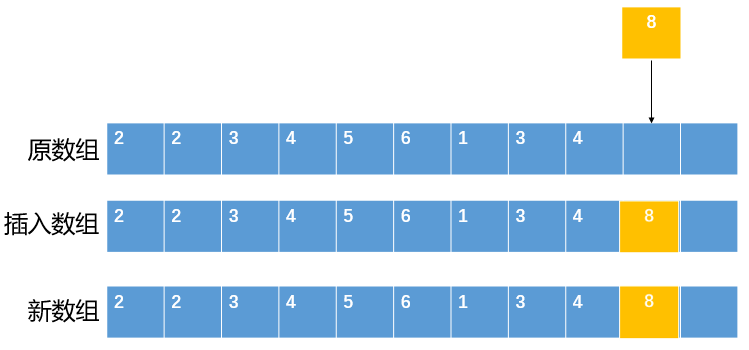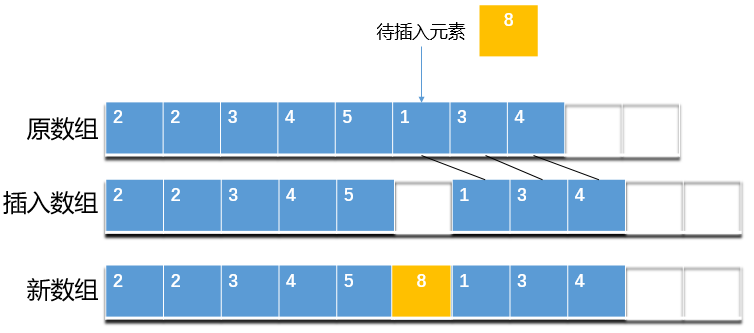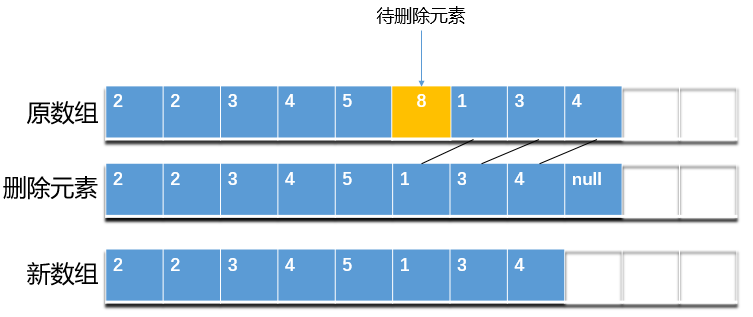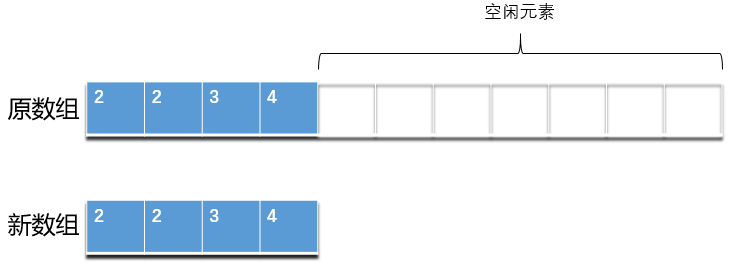ArrayList源碼分析-jdk11 (18.9)
1.概述
ArrayList 是一種變長的集合類,基於定長數組實現。ArrayList 允許空值和重複元素,當往 ArrayList 中添加的元素數量大於其底層數組容量時,其會通過擴容機制重新生成一個更大的數組。另外,由於 ArrayList 底層基於數組實現,所以其可以保證在 O(1) 複雜度下完成隨機查找操作。其他方面,ArrayList 是非執行緒安全類,並發環境下,多個執行緒同時操作 ArrayList,會引發不可預知的錯誤。
ArrayList 是大家最為常用的集合類,作為一個變長集合類,其核心是擴容機制。所以只要知道它是怎麼擴容的,以及基本的操作是怎樣實現就夠了。本文後續內容將圍繞jdk11 (18.9)中ArrayList的源碼展開敘述。
2.源碼分析
2.1參數
1、ArrayList默認容量為10DEFAULT_CAPACITY注釋
2、ArrayList並不是在初始化的時候就創建了 DEFAULT_CAPACITY=10 的數組。而是在往裡邊 add 第一個數據的時候會擴容到 10 elementData注釋
private static final long serialVersionUID = 8683452581122892189L;
/**
* 默認初始化容量
*/
private static final int DEFAULT_CAPACITY = 10;
/**
* 用於空實例的共享空數組實例。
*/
private static final Object[] EMPTY_ELEMENTDATA = {};
/**
* Shared empty array instance used for default sized empty instances. We
* distinguish this from EMPTY_ELEMENTDATA to know how much to inflate when
* first element is added.
* 用於默認大小的空實例的共享空數組實例。我們將其與EMPTY_ELEMENTDATA分開來,以了解添加第一個元素時要膨脹多少。
*/
private static final Object[] DEFAULTCAPACITY_EMPTY_ELEMENTDATA = {};
/**
* The array buffer into which the elements of the ArrayList are stored.
* The capacity of the ArrayList is the length of this array buffer. Any
* empty ArrayList with elementData == DEFAULTCAPACITY_EMPTY_ELEMENTDATA
* will be expanded to DEFAULT_CAPACITY when the first element is added.
存儲ArrayList元素的數組緩衝區,ArrayList的容量是這個數組緩衝區的長度。當第一個元素被添加的時候,elementData == DEFAULTCAPACITY_EMPTY_ELEMENTDATA 將被擴展成 DEFAULT_CAPACITY
*/
transient Object[] elementData; // non-private to simplify nested class access
/**
* The size of the ArrayList (the number of elements it contains).
* 數組大小
* @serial
*/
private int size;
2.2 構造方法
ArrayList 有三個構造方法,無參構造方法、構造空的具有特定初始容量值方法、構造一個包含指定集合元素的列表,按照集合的迭代器返回它們的順序。
2.2.1 無參構造方法
注意下圖中的注釋Constructs an empty list with an initial capacity of ten 調用無參構造方法,默認構造一個容量為10的空list.
/**
* Constructs an empty list with an initial capacity of ten.
*/
public ArrayList() {
this.elementData = DEFAULTCAPACITY_EMPTY_ELEMENTDATA;
}
2.2.2 構造空的具有特定初始容量值方法
1、在知道將會向 ArrayList 插入多少元素的情況下 2、在有大量數據寫入 時;一定要初始化指定長度。
/**
* Constructs an empty list with the specified initial capacity.
*
* @param initialCapacity the initial capacity of the list
* @throws IllegalArgumentException if the specified initial capacity
* is negative
*/
public ArrayList(int initialCapacity) {
if (initialCapacity > 0) {
this.elementData = new Object[initialCapacity];
} else if (initialCapacity == 0) {
this.elementData = EMPTY_ELEMENTDATA;
} else {
throw new IllegalArgumentException("Illegal Capacity: "+
initialCapacity);
}
}
2.2.3構造一個包含指定集合元素的列表,按照集合的迭代器返回它們的順序
/**
* Constructs a list containing the elements of the specified
* collection, in the order they are returned by the collection's
* iterator.
構造一個包含指定集合元素的列表,按照集合的迭代器返回它們的順序
* @param c the collection whose elements are to be placed into this list
* @throws NullPointerException if the specified collection is null
*/
public ArrayList(Collection<? extends E> c) {
elementData = c.toArray();
if ((size = elementData.length) != 0) {
// defend against c.toArray (incorrectly) not returning Object[]
//防禦c.toArray(錯誤地)不返回Object[]
// (see e.g. //bugs.openjdk.java.net/browse/JDK-6260652)
// jdk bug(Arrays內部實現的ArrayList的toArray()方法的行為與規範不一致) 15年修復;
if (elementData.getClass() != Object[].class)
elementData = Arrays.copyOf(elementData, size, Object[].class);
} else {
// replace with empty array.
this.elementData = EMPTY_ELEMENTDATA;
}
}
JDK-6260652 (see e.g. //bugs.openjdk.java.net/browse/JDK-6260652)
簡單來說就是,就是下圖程式碼會產生的情況。
Object[] objects = new String[]{"string"};
objects[0] = 1;
/**
Exception in thread "main" java.lang.ArrayStoreException: java.lang.Integer
*/
產生原因
public Object[] toArray() {
return a.clone();
}
Arrays內部實現的ArrayList的toArray()方法的行為與規範不一致。根據JLS規範String[]的clone方法返回的也是String[]類型,所以toArray()方法返回的真實類型是String[],所以個toArray()[0]賦值時可能會導致類型不匹配的錯誤
jdk11中的Arrays內部實現的ArrayList的toArray()方法。所以調用copyOf()返回值類型為Object[]
public Object[] toArray() {
return Arrays.copyOf(a, a.length, Object[].class);
}
2.3常見方法
2.3.1插入
對於數組(線性表)結構,插入操作分為兩種情況。一種是在元素序列尾部插入,另一種是在元素序列其他位置插入。ArrayList 的源碼里也體現了這兩種插入情況,如下:
/**
* This helper method split out from add(E) to keep method
* bytecode size under 35 (the -XX:MaxInlineSize default value),
* which helps when add(E) is called in a C1-compiled loop.
(這個輔助方法是從add(E)方法分離而來的,為了保持方法位元組碼低於35,這將有助於add(E)方法調用C1編譯循環)
*/
private void add(E e, Object[] elementData, int s) {
if (s == elementData.length)
elementData = grow();
/**
private Object[] grow() {
return grow(size + 1);
}**/
//將新元素插入序列尾部
elementData[s] = e;
size = s + 1;
}
/**
* Inserts the specified element at the specified position in this
* list. Shifts the element currently at that position (if any) and
* any subsequent elements to the right (adds one to their indices).
在此列表的指定位置插入指定的元素。將當前位於該位置的元素(如果有)和任何後續元素向右移動(在其索引中添加一個元素)
* @param index index at which the specified element is to be inserted
* @param element element to be inserted
* @throws IndexOutOfBoundsException {@inheritDoc}
*/
public void add(int index, E element) {
rangeCheckForAdd(index);
modCount++;
final int s;
Object[] elementData;
if ((s = size) == (elementData = this.elementData).length)
elementData = grow();
// 2. 將 index 及其之後的所有元素都向後移一位
System.arraycopy(elementData, index,
elementData, index + 1,
s - index);
// 3. 將新元素插入至 index 處
elementData[index] = element;
size = s + 1;
}
2.3.1.1元素序列尾部插入
- 檢測數組是否有足夠的空間插入
- 將新元素插入至序列尾部
如下圖:

2.3.1.2元素序列指定位置(假設該位置合理)插入
- 檢測數組是否有足夠的空間
- 將 index 及其之後的所有元素向後移一位
- 將新元素插入至 index 處
如下圖:

從上圖可以看出,將新元素插入至序列指定位置,需要先將該位置及其之後的元素都向後移動一位,為新元素騰出位置。這個操作的時間複雜度為O(N),頻繁移動元素可能會導致效率問題,特別是集合中元素數量較多時。在日常開發中,若非所需,我們應當盡量避免在大集合中調用第二個插入方法。
2.3.2 ArrayList 的擴容機制
對於變長數據結構,當結構中沒有空餘空間可供使用時,就需要進行擴容。在 ArrayList 中,當空間用完,其會按照原數組空間的1.5倍進行擴容。相關源碼如下:
/** 擴容的入口方法 */
/**
* Increases the capacity of this {@code ArrayList} instance, if
* necessary, to ensure that it can hold at least the number of elements
* specified by the minimum capacity argument.
*增加{@code ArrayList}實例的容量,如果必需的,以確保它至少可以容納minimum capacity參數指定的元素數
* @param minCapacity the desired minimum capacity
*/
public void ensureCapacity(int minCapacity) {
if (minCapacity > elementData.length
&& !(elementData == DEFAULTCAPACITY_EMPTY_ELEMENTDATA
&& minCapacity <= DEFAULT_CAPACITY)) {
modCount++;
grow(minCapacity);
}
}
/** 擴容的核心方法 */
/**
* Returns a capacity at least as large as the given minimum capacity.
* Returns the current capacity increased by 50% if that suffices.
* Will not return a capacity greater than MAX_ARRAY_SIZE unless
* the given minimum capacity is greater than MAX_ARRAY_SIZE.
返回至少等於給定最小值的容量容量。返回當前容量增加50%,如果夠了。不會返回大於MAX_ARRAY_SIZE的容量,除非給定的最小容量大於MAX_ARRAY_SIZE
* @param minCapacity the desired minimum capacity
* @throws OutOfMemoryError if minCapacity is less than zero
*/
private int newCapacity(int minCapacity) {
// overflow-conscious code
int oldCapacity = elementData.length;
int newCapacity = oldCapacity + (oldCapacity >> 1); //舊容量大小+在舊容量基礎上增加50%(左移1位相當於除以2)
if (newCapacity - minCapacity <= 0) {
if (elementData == DEFAULTCAPACITY_EMPTY_ELEMENTDATA)
return Math.max(DEFAULT_CAPACITY, minCapacity);
if (minCapacity < 0) // overflow
throw new OutOfMemoryError();
return minCapacity;
}
return (newCapacity - MAX_ARRAY_SIZE <= 0)
? newCapacity
: hugeCapacity(minCapacity);
}
private static int hugeCapacity(int minCapacity) {
if (minCapacity < 0) // overflow
throw new OutOfMemoryError();
// 如果最小容量超過 MAX_ARRAY_SIZE,則將數組容量擴容至 Integer.MAX_VALUE
return (minCapacity > MAX_ARRAY_SIZE) ?
Integer.MAX_VALUE :
MAX_ARRAY_SIZE;
}
2.3.3刪除
不同於插入操作,ArrayList 沒有無參刪除方法。所以其只能刪除指定位置的元素或刪除指定元素,這樣就無法避免移動元素(除非從元素序列的尾部刪除)。相關程式碼如下:
/** 刪除指定位置的元素 */
/**
* Removes the element at the specified position in this list.
* Shifts any subsequent elements to the left (subtracts one from their
* indices).
*
* @param index the index of the element to be removed
* @return the element that was removed from the list
* @throws IndexOutOfBoundsException {@inheritDoc}
*/
public E remove(int index) {
Objects.checkIndex(index, size);
final Object[] es = elementData;
// 返回被刪除的元素值
@SuppressWarnings("unchecked")
E oldValue = (E) es[index];
fastRemove(es, index);
return oldValue;
}
/** 從列表中刪除第一個出現的指定元素(如果存在)。
如果列表不包含元素,則不變。更準確地說,刪除索引最低的元素 */
/**
* Removes the first occurrence of the specified element from this list,
* if it is present. If the list does not contain the element, it is
* unchanged. More formally, removes the element with the lowest index
* {@code i} such that
* {@code Objects.equals(o, get(i))}
* (if such an element exists). Returns {@code true} if this list
* contained the specified element (or equivalently, if this list
* changed as a result of the call).
*
* @param o element to be removed from this list, if present
* @return {@code true} if this list contained the specified element
*/
public boolean remove(Object o) {
final Object[] es = elementData;
final int size = this.size;
int i = 0;
// 遍曆數組,查找要刪除元素的位置
found: {
if (o == null) {
for (; i < size; i++)
if (es[i] == null)
break found;
} else {
for (; i < size; i++)
if (o.equals(es[i]))
break found;
}
return false;
}
fastRemove(es, i);
return true;
}
/**
* Private remove method that skips bounds checking and does not
* return the value removed.
*/
private void fastRemove(Object[] es, int i) {
modCount++;
final int newSize;
if ((newSize = size - 1) > i)
// 將 index + 1 及之後的元素向前移動一位,覆蓋被刪除值
System.arraycopy(es, i + 1, es, i, newSize - i);
// 將最後一個元素置空,並將 size 值減1
es[size = newSize] = null;
}
上面的刪除方法並不複雜,這裡以第一個刪除方法為例,刪除一個元素步驟如下:
- 獲取指定位置 index 處的元素值
- 將 index + 1 及之後的元素向前移動一位
- 將最後一個元素置空,並將 size 值減 1
- 返回被刪除值,完成刪除操作
如下圖:

現在,考慮這樣一種情況。我們往 ArrayList 插入大量元素後,又刪除很多元素,此時底層數組會空閑處大量的空間。因為 ArrayList 沒有自動縮容機制,導致底層數組大量的空閑空間不能被釋放,造成浪費。對於這種情況,ArrayList 也提供了相應的處理方法,如下:
/** 將數組容量縮小至元素數量 */
/**
* Trims the capacity of this {@code ArrayList} instance to be the
* list's current size. An application can use this operation to minimize
* the storage of an {@code ArrayList} instance.
*/
public void trimToSize() {
modCount++;
if (size < elementData.length) {
elementData = (size == 0)
? EMPTY_ELEMENTDATA
: Arrays.copyOf(elementData, size);
}
}

我們可以使用trimToSize()手動觸發 ArrayList 的縮容機制,釋放多餘的空間。
2.3.4 遍歷
ArrayList 實現了 RandomAccess 介面(該介面是個標誌性介面),表明它具有快速隨機訪問的能力。ArrayList 底層基於數組實現,所以它可在常數階的時間內完成隨機訪問,效率很高。對 ArrayList 進行遍歷時,一般情況下,我們喜歡使用 foreach 循環遍歷,但這並不是推薦的遍歷方式。ArrayList 具有隨機訪問的能力,如果在一些效率要求比較高的場景下,更推薦下面這種方式:
for (int i = 0; i < list.size(); i++) {
list.get(i);
}
官網還特意說明了,如果是實現了這個介面的 List,那麼使用for循環的方式獲取數據會優於用迭代器獲取數據
3.其他細節
3.1 快速失敗機制
在 Java 集合框架中,很多類都實現了快速失敗機制。該機制被觸發時,會拋出並發修改異常ConcurrentModificationException,這個異常大家在平時開發中多多少少應該都碰到過。關於快速失敗機制,ArrayList 的注釋里對此做了解釋,這裡引用一下:
The iterators returned by this class』s iterator() and
listIterator(int) methods are fail-fast
if the list is structurally modified at any time after the iterator is
created, in any way except through the iterator』s own
ListIterator remove() or ListIterator add(Object) methods,
the iterator will throw a ConcurrentModificationException. Thus, in the face of
concurrent modification, the iterator fails quickly and cleanly, rather
than risking arbitrary, non-deterministic behavior at an undetermined
time in the future.
上面注釋大致意思是,ArrayList 迭代器中的方法都是均具有快速失敗的特性,當遇到並發修改的情況時,迭代器會快速失敗,以避免程式在將來不確定的時間裡出現不確定的行為。
以上就是 Java 集合框架中引入快速失敗機制的原因,並不難理解,這裡不多說了。
3.2 關於遍歷時刪除
遍歷時刪除是一個不正確的操作,即使有時候程式碼不出現異常,但執行邏輯也會出現問題。關於這個問題,阿里巴巴 Java 開發手冊里也有所提及。這裡引用一下:
【強制】不要在 foreach 循環里進行元素的 remove/add 操作。remove 元素請使用 Iterator 方式,如果並發操作,需要對 Iterator 對象加鎖。
相關程式碼(稍作修改)如下:
List<String> a = new ArrayList<String>();
a.add("1");
a.add("2");
for (String temp : a) {
System.out.println(temp);
if("1".equals(temp)){
a.remove(temp);
}
}
}
相信有些朋友應該看過這個,並且也執行過上面的程式。上面的程式執行起來不會雖不會出現異常,但程式碼執行邏輯上卻有問題,只不過這個問題隱藏的比較深。我們把 temp 變數列印出來,會發現只列印了數字1,2沒列印出來。初看這個執行結果確實很讓人詫異,不明原因。如果死摳上面的程式碼,我們很難找出原因,此時需要稍微轉換一下思路。我們都知道 Java 中的 foreach 是個語法糖,編譯成位元組碼後會被轉成用迭代器遍歷的方式。所以我們可以把上面的程式碼轉換一下,等價於下面形式:
List<String> a = new ArrayList<>();
a.add("1");
a.add("2");
Iterator<String> it = a.iterator();
while (it.hasNext()) {
String temp = it.next();
System.out.println("temp: " + temp);
if("1".equals(temp)){
a.remove(temp);
}
}
這個時候,我們再去分析一下 ArrayList 的迭代器源碼就能找出原因。
private class Itr implements Iterator<E> {
int cursor; // index of next element to return
int lastRet = -1; // index of last element returned; -1 if no such
int expectedModCount = modCount;
public boolean hasNext() {
return cursor != size;
}
@SuppressWarnings("unchecked")
public E next() {
// 並發修改檢測,檢測不通過則拋出異常
checkForComodification();
int i = cursor;
if (i >= size)
throw new NoSuchElementException();
Object[] elementData = ArrayList.this.elementData;
if (i >= elementData.length)
throw new ConcurrentModificationException();
cursor = i + 1;
return (E) elementData[lastRet = i];
}
final void checkForComodification() {
if (modCount != expectedModCount)
throw new ConcurrentModificationException();
}
// 省略不相關的程式碼
}
我們一步一步執行一下上面的程式碼,第一次進入 while 循環時,一切正常,元素 1 也被刪除了。但刪除元素 1 後,就無法再進入 while 循環,此時 it.hasNext() 為 false。原因是刪除元素 1 後,元素計數器 size = 1,而迭代器中的 cursor 也等於 1,從而導致 it.hasNext() 返回false。歸根結底,上面的程式碼段沒拋異常的原因是,循環提前結束,導致 next 方法沒有機會拋異常。不信的話,大家可以把程式碼稍微修改一下,即可發現問題:
List<String> a = new ArrayList<>();
a.add("1");
a.add("2");
a.add("3");
Iterator<String> it = a.iterator();
while (it.hasNext()) {
String temp = it.next();
System.out.println("temp: " + temp);
if("1".equals(temp)){
a.remove(temp);
}
}
以上是關於遍歷時刪除的分析,在日常開發中,我們要避免上面的做法。正確的做法使用迭代器提供的刪除方法,而不是直接刪除。


